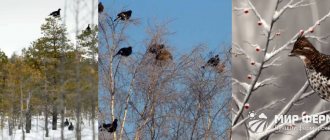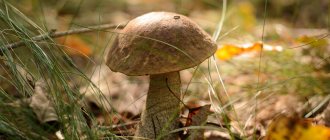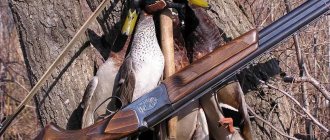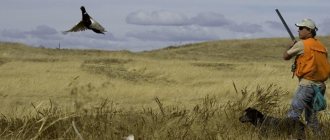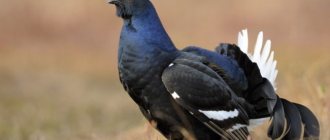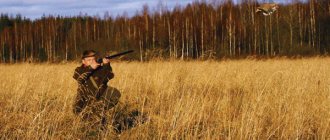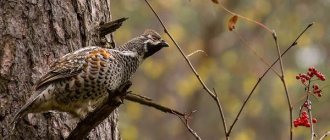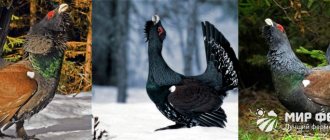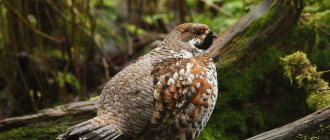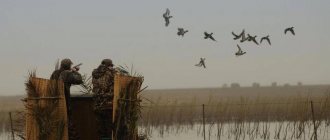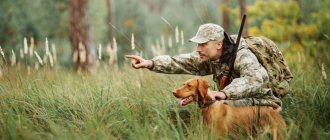Description of woodcock
Woodcock is also called wood sandpiper. It can be found in the temperate and subarctic zones of Europe and Asia. The bird prefers old deciduous and mixed forests with high humidity. You can meet woodcock in forest wastelands and small copses.
The bird leads a solitary lifestyle and is in contact with relatives only during the breeding season, so it is almost impossible to spot a large number of woodcocks in the forest.
The game is large enough to be of interest to the hunter. The body reaches 35 cm in length, woodcocks weigh up to 400 g. The feathers are brown, variegated, the body is quite rounded, the lower part near the paws is lighter, the wings are slightly darker. The feathers are predominantly rusty-red, which provides the woodcock with good secrecy. Thanks to this color, the bird is almost impossible to detect in last year’s foliage, where it prefers to hide.
A distinctive feature of woodcocks is their long narrow beak. In some individuals it reaches 9 centimeters in length.
Externally, the female and the male are practically indistinguishable. Hunters distinguish the sex of a bird by ear. The female makes a “tscking” sound, the male makes a quiet grunting sound. In general, the female and the male become close only in the spring and stay together for some time. In this case, the female always stays in front of the male, which also helps to distinguish the sex of the bird.
During the day, the sandpiper hides in dead wood or dense bushes. The bird goes out in search of food at dusk.
Hunting season
Wood sandpiper can be hunted throughout the year, before the onset of winter cold.
Woodcock hunting begins in the spring. The season opens in March and lasts 10 days. Traction (the period of searching for partners) in these birds begins approximately 7-10 days after they arrive from wintering. Hunting during the feeding period is most successful, as birds lose caution while searching for a partner. During this period, woodcock hunting with decoy performs well.
Hunting in summer is somewhat more difficult, since the bird prefers to stay in cover during the daytime. During this period, you will need great skill to get the desired trophy.
Hunting by season
The hunter's heartbeat increases its speed like the movements of a March cat in the first season of the opening of the woodcock hunt. The second and third seasons bring him a feeling of fiery excitement and satisfaction from the process:
in spring
The end of the first month of spring opens the sandpiper shooting season for 10 days. At this time, the feathered individual is just returning from the southern lands. Bird hunting in spring takes place at the time of its current.
Hunting for woodcock in the spring by calling is effective. With the help of decoys you can easily lure a bird and make quality shots. Other bait methods work just as well at this time. The main thing is to follow the rule - to identify only males for your purpose.
The period of 10 days is limited precisely by the duration of the mating season of the birds. After it, the so-called “rash” begins - the time when the woodcock begins direct reproduction. Trapping is prohibited here.
Spring is also good for any shooter due to the wonderful feelings experienced during this period. The forest and nature itself seem to come to life, opening their “pores” after a long winter sleep. It's very beautiful and exciting. Both visually and by the nature of the sounds at these moments.
In summer
Summer is a longer period for catching birds. The weather is warm, nature lives and “breathes deeply.” The beauty and originality are also unique. There are a lot of birds. By using certain methods of sandpiper hunting, you can get a large amount of prey during summer shooting, and get a lot of positive emotions from walking through the forest.
It is typical to use sandpiper fishing in the summer with dogs, on mud or in drops. Such methods are each dynamic, detailed and have their own originality. But this is not meant by simplicity. Inexperience or carelessness in their use by individual shooters will lead to failure in the end.
in autumn
The golden time of nature is not inferior to the two periods described above either in the quality of catching feathered males of wood waders, or in receiving a lot of emotions from this process.
In autumn, birds' habitats move to wetter zones. In reed thickets, a zone close to small bodies of water. There are frequent cases when flying prey can be found in places inhabited by people. It can live in the fall in human gardens or gardens.
We can only say positive things about the quality of the autumn catch. During the spring-summer period, the bird went through all the intervals of feeding and preparing for the long movement south in winter. Woodcock fattens up a decent layer of fat in the fall. Flights are already less active. Due to the increase in mass and before flying south, the sandpiper tries to fly less. Males simply have a hard time. Such a moment only plays into the hands of the shooter. At these moments, his accuracy is the main factor in defeating the bird.
Hunting with a dog
Woodcock hunting with a pointer is preferable in the summer. The task of a well-trained hunting dog is to track woodcock during the day. A hunter with a dog must comb the favorite places of this bird - bushes, shallow ravines, forest edges.
Having discovered hidden prey, the dog starts barking, and the hunter at this time must be ready to fire a shot. An alarmed woodcock rises up, leaving its shelter, so the shooting is carried out on the fly.
The hunter must be prepared for the fact that he will have to collect game and finish off wounded animals, since there is often not enough time to aim well. Here a dog will also come to the rescue and find shot game. It is very difficult to look for trophies without a dog, because the color of the woodcock allows it to remain unnoticed against the background of dried summer grass and bushes.
Hunting with decoy
You can hunt woodcock with a decoy made with your own hands.
If you don’t have a well-trained dog, you can hunt with a decoy. This type of woodcock hunting in the spring is preferable than at any other time of the year, because the sound of the decoy imitates the mating cry of the bird.
For this kind of woodcock hunting in the spring you will need a high-quality electronic decoy. Typically, decoys imitate the sound made by two males fighting over a female. A young male will “bite” on such bait and try to join the fight.
The decoy must be of good quality, since clear sound is necessary to attract birds. Due to the specific nature of the sandpiper’s voice, it is better to use special electronic decoys, but some craftsmen make them themselves.
The principle of hunting with a decoy is quite simple. The hunter walks around the habitats of woodcock or wood sandpiper, periodically turning on the decoy for a short time, and then listening. If a young male is hiding in a bush, after a few minutes he will make a characteristic sound and fly out of his hiding place. Further success depends on the reaction speed and accuracy of the hunter. You will have to shoot a woodcock on the fly, since it is impossible to predict the bird’s appearance from cover.
You should also be prepared to kill a wounded animal, because due to the speed of its flight, it is often impossible to kill a woodcock with one shot. A wounded bird will get scared and try to hide on the ground.
Hunting in the spring
The most popular can rightfully be called spring hunting. It generally does not last long; more time is spent on preparation, which consists of selecting a more suitable place for shooting, placing hunters around the territory (there should be at least a hundred meters between them). Experienced hunters know that in windy weather the bird flies higher, and in calm weather it flies closer to the ground. The flight speed also depends on the weather; it moves more slowly when it is cloudy and not very windy.
Spring draft is a kind of current that begins after the arrival of birds from warm regions. Woodcock flies over large areas of the forest, but only in the evening, closer to sunset. While flying, the bird announces its presence with a loud, peculiar cry; the females flutter and the males grunt.
But it is quite possible to miss the moment of flight, although such birds are usually heard from about eighty meters away. Before hunting, you need to choose a good place for viewing and shooting, arriving no earlier than an hour before sunset. When choosing a location, you need to pay attention to the places where your victim is most likely to fly, as well as the height of nearby trees.
Your success will largely depend on your knowledge of the area (local rangers and hunters can help with this). Plus the ability to choose a good shooting spot, and luck is in your pocket. Woodcocks do not change their spring habitat; most of all they like forests with clearings. They fly, as a rule, over the tops of forest trees.
Many inexperienced hunters make the mistake of casually shooting at a low-flying woodcock. They often miss or make wounded attacks, believing that the prey is already in their pocket. Do not underestimate these birds, when running away from danger, they very cleverly hide between trees, without even touching small branches.
Summer hunt for “dirt”
In the hot summer, woodcocks visit cattle grazing areas. They look for food in droppings, which is why this type of hunting is called “dirt” hunting.
Due to the hot weather, characteristic traces of the presence of a small bird remain in the droppings - holes from a long beak, traces of paws, white spots of droppings.
Having discovered the favorite place of these birds, the hunter should come before sunset and find a good hiding place. Shooting is carried out on the fly, until the bird lands and has time to hide in the grass or bushes. This kind of hunting requires excellent accuracy. It is important that the hunter does not leave his shelter for some time, so as not to frighten away new flying birds.
Hunting methods
- On drops. It is based on the fact that in rainy and windy weather the bird becomes less careful because it cannot react to every rustle of leaves and crunch of branches. In addition, in such situations, woodcocks live in more open areas, which allows them to be seen better. Hunters take advantage of this when they get close enough. They are unable to quickly fly away from danger, since the body is wet, this is another factor that plays in favor of the hunter.
- On autumn rashes. Requires the participation of a four-legged friend. In autumn, birds often stay in flocks and, rising to the top and running away from your setter or spaniel, give you the right to choose a target. You can hunt like this all day long; as a rule, everyone starts in the early morning. It is preferable to use guns with greater accuracy, since the birds will fly quite quickly.
- On the dirt. At the end of summer, woodcocks very often visit places where cattle graze to find food in their droppings. It’s worth waiting for just this moment to replenish your trophies with good aim. During such a hunt, a dog is only needed to collect killed birds.
- On the water. Just like the previous event, it is held in August and is associated with cattle. The difference is that in this case the birds fly to the watering hole and swim. It is worth waiting for them in advance before sunset, arranging an ambush. It is better to collect the killed bird at the end of the hunt with a flashlight.
Hunting in the autumn season
In the autumn, it is better to hunt the bird before sunset.
To hunt woodcock in the fall, choose the beginning or middle of September. The autumn draft is noticeably weaker than the spring one, so the wood sandpiper during this period is not such an easy prey as in the spring. The bird remains cautious and reluctantly leaves its hiding place, moving quickly and abruptly.
In autumn woodcock hunting, you can also use a decoy during the pull, but this method is ineffective, unlike in the spring.
To hunt woodcock in the fall without a dog, you should think carefully about the shelter, first going around all the places where the wood sandpiper may be hiding. Autumn cravings appear in the morning, before dawn, and in the evening, after sunset. During these periods, the hunter should hide in a shelter, about 40 meters from the woodcock’s habitat, and be ready to start shooting the birds that appear.
Basic principles of woodcock hunting
Hunting the wood sandpiper is not easy; it is important not only to know its habits, but also to be able to choose a suitable place for a shot (Figure 1).
Spring hunting for woodcock by traction is easier and more successful, since in the fall the mating season is highly dependent on the weather, but it also has its own principles:
- It is worth giving preference to clearings covered with bushes and undergrowth; it is good if there are small bare clearings in the low forest.
- The forest in clearings should be different in age - birds pull along the edges of young forest, earlier felling, and edges overgrown with young growth are also suitable.
- The best places are forest swampy clearings, overgrown with low bushes, turning into each other.
- In clearings surrounded by an old forest, you need to be located right on their border; on a chain of clearings, you need to stand in the narrowest place where they turn into each other.
- Over-dried locations or heavily flooded with water, as well as isolated forest clearings in the middle of tall, dense trees, will be a bad option.
- Bridges of undergrowth connecting high thickets and marshy areas surrounded by undergrowth are ideal hunting grounds.
Figure 1. Woodcock is a rare, but extremely valuable game.
During the period of evening bird activity, it is necessary to get closer to the high-trunk part, and at dusk move to the center in the open area - this is necessary to quickly navigate the movements of the game.
